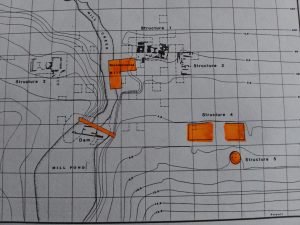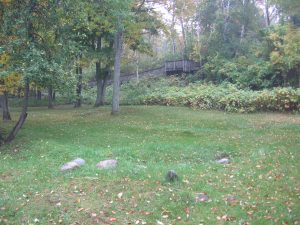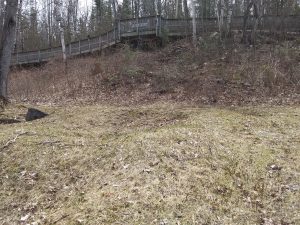Watching the sawmill operate is one of the highlights of a visit to Historic Mill Creek. Seeing the original grist mill stones reunited in the American Millwright’s House is the result of good historical detective work. However, milling was the not the only enterprise at Mill Creek.
According to the original land claim by Robert Campbell’s heirs, the property was “commonly known by the name of Campbell’s farm.” Among the improvements listed on Private Claim 334 were a house, a grist and sawmill, at least 40 cultivated acres, a large orchard and valuable buildings.
Michael Dousman purchased the property in 1819. He was a large landowner, with additional property on Mackinac and Bois Blanc islands. He held lucrative contracts to supply Fort Mackinac with beef and hay, which he supplied from these farms. The gristmill closed by 1839, and the sawmill was moved to Cheboygan in the mid-1840s.

After Dousman’s death in 1854, Jacob A.T. Wendell of Mackinac Island bought the property. In 1867 Putman’s Magazine published a story about an unsuccessful trout fishing expedition to Mill Creek. It stated, “there had formerly been a cleared spot of land about the mill, but it was fast growing up again.”
Also shortly after the Civil War, a man named Young, a tenant of Wendell, built a house at the foot of the Mill Creek bluff and engaged in the manufacture of lime. After two years he moved on to other pursuits. At that point Wendell arranged with Charles Bennett to move into the house and see that no one trespassed on the private claim. In 1916 Angeline Bennett, Charles’s widow, testified in an affidavit that they had “lived upon and occupied said property for upwards of fifty years.” One of their descendants visited Historic Mill Creek in 1993 and remembered a farm on the bluff and apple trees.
The Wendell family sold the property to the Petoskey Mackinaw Lime Company in about 1902, but apparently the Bennetts continued living there until the house, which Angeline described as “at the foot of the bluff where the quarry is now located,” burned down in 1911. The Petoskey Mackinaw Lime Company mined limestone and clay for road building into the 1920s before letting the land tax revert to the State of Michigan.

Is there any evidence of this agricultural activity visible at Historic Mill Creek today? Old apple trees are still scattered among the reconstructed buildings near the creek. Faint traces of two structures are visible across the path from the sawpit at the foot of the hill. They are most visible in the spring before the foliage comes out and in late fall when everything has died back again. Mapping and limited archaeological testing was carried out in 1988.
The first foundation is a large rectangle, seventy-one feet long by twenty feet wide, with twenty-foot door gaps in the long north and south walls. This would seem most likely to be a barn. Nineteenth- century artifacts, including red transfer-printed ceramic sherds and a metal plate from an instrument case dated 1873, were found here.

The second ruin is circular, and so has been interpreted as a silo. It is about thirteen feet in diameter. It did not contain as many artifacts, only some late nineteenth- and early twentieth-century bottles and tin cans. There was evidence for a thin wood floor about two feet below the ground surface.
Larger scale excavation at both structures in the future may reveal more about this interesting facet of life at Mill Creek.









